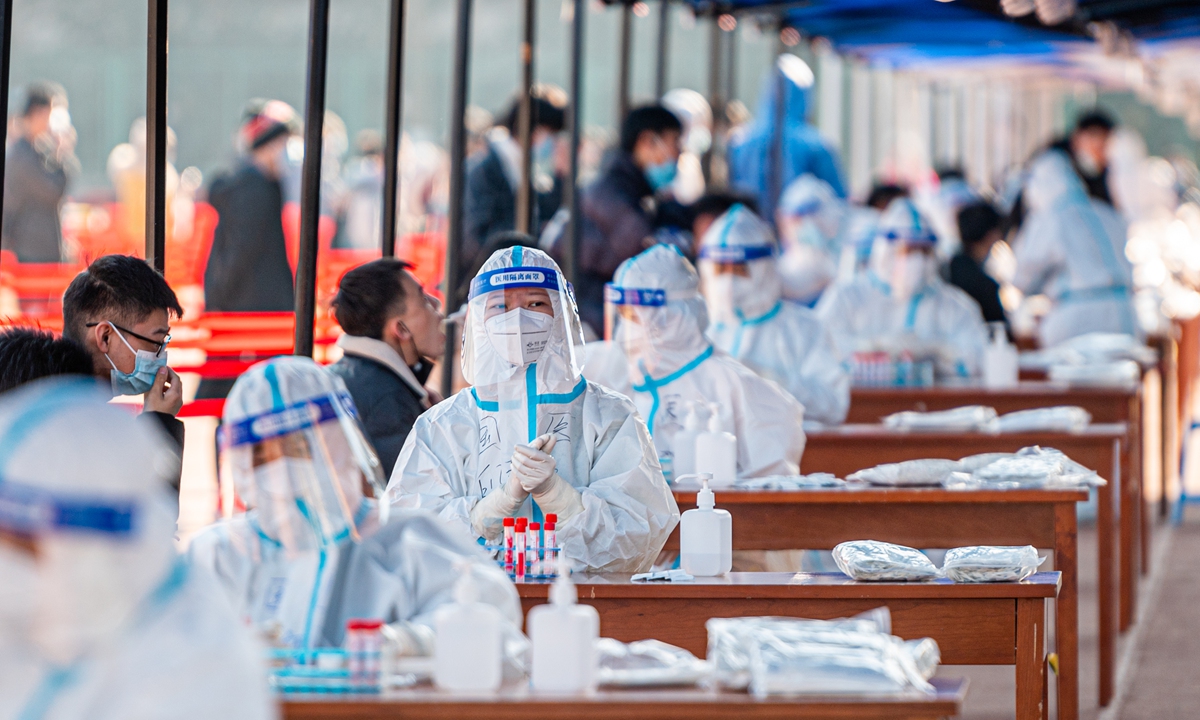
Medical staff conduct nucleic acid tests at the Northwestern Polytechnical University in Xi'an, Northwest China's Shaanxi Province on December 21, 2021. Photo: VCG
The historic Chinese city of Xi'an, home to about 13 million people, tightened travel controls and locked down communities on Wednesday to combat a growing COVID-19 outbreak after the detection of more than 140 local cases within two weeks sparked great concerns of wider transmission.
The city in Northwest China's Shaanxi Province also shut down 3,574 schools and organized online classes. Large indoor recreation venues were suspended and company employees were advised to work from home.
These strict measures came after a city-wide nucleic acid testing program starting from Sunday, which detected 42 cases on Monday and 52 cases on Tuesday. So far, the outbreak has affected five other cities - Xianyang and Yan'an in Shaanxi, Zhoukou in Central China's Henan Province, Dongguan in South China's Guangdong Province, and Beijing.
The second round of city-wide nucleic acid testing in Xi'an detected 127 positive cases, local authority announced on Wednesday night.
Amid the increasing number of new cases and the fast community transmission, Xi'an is facing a huge test of its governance capability compared with other cities that were recently engaged in similar battles against COVID-19 resurgences.
The city's response to the emergency and its implementation of the country's strategy of pursing a dynamic zero-case policy, which has been proven to be effective, is plagued by broad questions.
"Chaotic" is the word that many local residents would use to describe the past two days. The
Health Code system crashed for almost the whole day on Monday, so people could not take public transportation, go to work or even return home, as these activities require a scan of the QR code through the system.
"Worrying," some graduate students complained on Twitter-like Sina Weibo, saying that they felt helpless as they were facing the problem of coming to the city to attend postgraduate examinations.
Some people questioned why the city has conducted a full-scale epidemiological survey at this early stage, since the specific transmission route is still not clear, and there is a lack of clear correlation among various transmission chains. Some said compared with a survey in Tianjin, in which the movements of patients could be pinpointed to minutes, the results in Xi'an were incomplete and unclear.
Random interviews of many Xi'an residents conducted by the Global Times on Wednesday showed a positive trend: Specific arrangements on postgraduate examinations were made; basic living necessities can be guaranteed; the situation is not that stressful.
As the city is about to enter a lockdown from midnight on Thursday, a local resident surnamed Ma told the Global Times that people have rushed to supermarkets to buy daily supplies as all households may only send one person outside once every two days to purchase necessities after the lockdown, except for emergencies.
Chinese public health experts said it is normal to see these complaints as several cities in the country have set a good example in precise prevention and control of the epidemic, and the Chinese people naturally hold high standards for local government responses to the emergency.
"A larger number of sporadic cases have not yet been linked to the current transmissions, which indicated that there has been hidden transmission in Xi'an," Lu Hongzhou, head of the Third People's Hospital of Shenzhen and member of the expert committee of national disease control and prevention, told the Global Times on Wednesday.
As the city is battling against the grave novel coronavirus, several reported cases of
hemorrhagic fever, a natural epidemic disease with a high fatality rate, also posed dual pressure to the city.
This outbreak has entered the peak period, Lu said, noting that the situation may not be put under control immediately. However, based on the dynamic zero-case strategy as well as the local government's swift adjustment of its management, it is expected to contain the virus' spread in about four weeks, Lu said.




